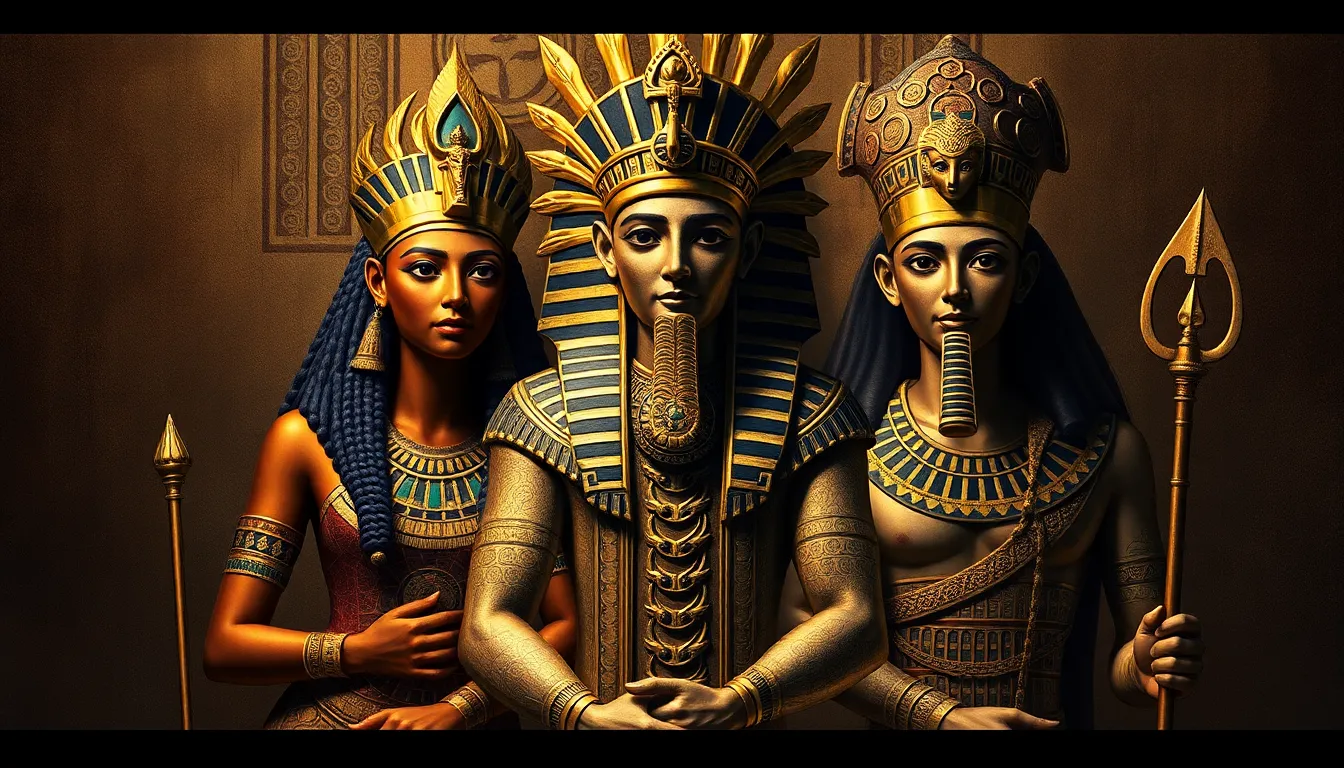The Divine Family: Isis, Osiris, and Horus
I. Introduction
In Ancient Egyptian mythology, the Divine Family of Isis, Osiris, and Horus holds a central place, symbolizing a complex interplay of themes such as life, death, and resurrection. These deities are not only important figures in the mythological landscape but also serve as archetypes for the values and beliefs of ancient Egyptian society.
Isis, often regarded as the ideal mother and wife, is known for her magical prowess and compassion. Osiris, her husband, embodies the principles of resurrection and the afterlife, while their son, Horus, represents kingship and authority. Together, they weave a narrative that has captivated audiences for millennia.
This article aims to explore the significance of the Divine Family, delving into their individual characteristics, interrelationships, and the lasting impact they have had on both ancient and modern cultures.
II. The Mythological Background
The origins of the Divine Family can be traced back to the earliest days of Egyptian mythology, where they emerged as vital figures in the pantheon of gods and goddesses. Their stories are deeply embedded in the cultural and religious fabric of ancient Egypt.
Key myths involving this divine trio include:
- The death and resurrection of Osiris.
- Isis’s quest to recover Osiris’s body.
- Horus’s battle for the throne against his uncle Set.
These myths not only entertain but also convey essential lessons about morality, justice, and the afterlife, reflecting the Egyptians’ beliefs about existence beyond death.
III. Isis: The Goddess of Magic and Motherhood
Isis is one of the most revered goddesses in Egyptian mythology, characterized by her nurturing qualities and magical abilities. She is often depicted with a throne-shaped crown and holding an ankh, symbolizing life.
Her role as a protector and nurturer is evident in various stories where she assists others through her wisdom and magical skills. Isis is often described as:
- The ideal mother.
- A powerful sorceress capable of healing.
- A devoted wife who seeks to restore her husband, Osiris.
One of the most famous myths associated with Isis is her relentless search for Osiris after his murder by Set. Utilizing her magical abilities, she not only revives him but also conceives their son, Horus, further solidifying her role as a key figure in the divine family.
IV. Osiris: The God of the Afterlife and Resurrection
Osiris is a prominent god associated with the afterlife, resurrection, and fertility. He is typically depicted as a mummified king, with green skin symbolizing rebirth, and holding a crook and flail, symbols of kingship and agriculture.
As the ruler of the underworld, Osiris plays a crucial role in the judgment of souls, determining their fate in the afterlife. His myth encompasses themes of death and resurrection:
- Osiris is murdered by his brother Set, who dismembers his body and scatters the pieces across Egypt.
- Isis, with the help of her sister Nephthys and the god Anubis, collects the pieces of Osiris and reassembles him.
- Osiris is resurrected, becoming the ruler of the afterlife, symbolizing the eternal cycle of life and death.
This story emphasizes the importance of resurrection in Egyptian belief, reinforcing the idea that death is not the end but a transition to a new existence.
V. Horus: The Falcon-headed God and Symbol of Kingship
Horus is often depicted as a falcon or as a man with a falcon head, symbolizing his dominion over the sky and his role as a protector of the pharaohs. He is associated with kingship and governance, embodying the ideals of power and justice.
Horus’s significance in Egyptian royalty is profound, as he is considered the divine ruler of Egypt and the protector of the nation. His myths often revolve around his battle for the throne against his uncle Set, which includes:
- The fierce rivalry that represents the struggle between order and chaos.
- Horus’s eventual triumph, signifying the rightful succession of kingship.
Horus’s victory over Set is celebrated as a foundational myth that legitimizes the pharaonic rule, linking the living kings to the divine.
VI. The Interconnectedness of the Divine Family
The relationships within the Divine Family are intricate and reflect broader themes in Egyptian mythology. Isis and Osiris’s love story, marked by betrayal and redemption, showcases the complexities of loyalty and sacrifice.
The dynamics between the three figures illustrate various themes:
- Love: The deep bond between Isis and Osiris, which transcends death.
- Betrayal: Set’s treachery against Osiris, representing chaos and disorder.
- Redemption: Horus’s quest to avenge his father and restore order to Egypt.
This interconnectedness emphasizes the cyclical nature of life and the importance of family ties in the face of adversity.
VII. Cultural Impact and Legacy
The influence of the Divine Family on ancient Egyptian religion and society is immense. They were revered in temples and worshipped by the masses, serving as figures of hope and guidance.
Their representation in art, literature, and architecture is plentiful. Notable examples include:
- Temple carvings depicting the resurrection of Osiris.
- Statues of Isis nurturing Horus.
- Horus’s image on the pharaonic crown, symbolizing divine right to rule.
Moreover, the legacy of the Divine Family extends into modern culture, influencing literature, films, and spiritual beliefs, demonstrating the timeless appeal of their stories.
VIII. Conclusion
The Divine Family of Isis, Osiris, and Horus represents a rich tapestry of mythology that has shaped the cultural landscape of ancient Egypt and beyond. Their stories reflect fundamental human experiences of love, loss, and the quest for meaning in the face of mortality.
As we delve deeper into these narratives, we uncover the layers of significance that continue to resonate today, inviting us to explore the richness of Egyptian mythology further.




